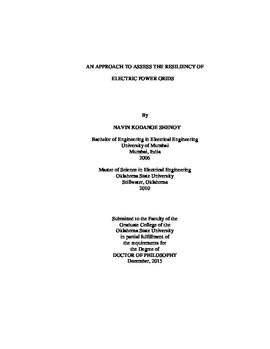| dc.contributor.advisor | Ramakumar, R. | |
| dc.contributor.author | Shenoy, Navin Kodange | |
| dc.date.accessioned | 2017-02-22T22:11:43Z | |
| dc.date.available | 2017-02-22T22:11:43Z | |
| dc.date.issued | 2015-12 | |
| dc.identifier.uri | https://hdl.handle.net/11244/48925 | |
| dc.description.abstract | Today's electric power grids face serious challenges due to overstressed networks, need to assimilate variable generation, strict environmental regulations and widespread weather-caused outages. There is an urgent need to improve grid resilience and system security more than ever before. Amidst such challenges, the best approach would be to focus primarily on the grid intelligence rather than implementing redundant preventive measures. The foundation of any intelligent operational strategy would be on the ability of the grid to assess its current dynamic state instantaneously. Traditional forms of real-time power system security assessment consist mainly of methods based on power flow analyses. Such methods do not consider the dynamics inherent in the system and hence, are static in nature. However, in order to capture the nonlinear dynamics present in the system, it is necessary to carry out time-domain simulations (TDS) that are computationally too involved to be performed in real-time. Machine learning (ML) techniques have the capability to organize data gathered from such simulations and thereby extract useful information in order to better assess the system security instantaneously. This dissertation presents a framework that would enable implementation of machine learning techniques for real-time assessment of grid resilience. An IEEE 14-bus test system is used in this work for simulation purposes. Firstly, a set of multiple steady-state operating points is generated by performing a SSA on the base case of the power system. Secondly, a TDS is performed on each operating point to assess the grid resilience against a specific disturbance, thus generating a database for this work. This work highlights the importance and need for selecting a few operating points as "landmarks" in the operational space under consideration for prediction of power system security. Further, a few heuristics are developed so as to rank all the operating points of the system. The proposed ranking methodologies are used to select the best landmarks in order to improve prediction accuracy on the original database, thereby enhancing the ability to assess grid resilience instantaneously. | |
| dc.format | application/pdf | |
| dc.language | en_US | |
| dc.rights | Copyright is held by the author who has granted the Oklahoma State University Library the non-exclusive right to share this material in its institutional repository. Contact Digital Library Services at lib-dls@okstate.edu or 405-744-9161 for the permission policy on the use, reproduction or distribution of this material. | |
| dc.title | Approach to assess the resiliency of electric power grids | |
| dc.contributor.committeeMember | Cheng, Qi | |
| dc.contributor.committeeMember | Ekneligoda, Nishantha | |
| dc.contributor.committeeMember | Chowdhary, Girish | |
| osu.filename | Shenoy_okstate_0664D_14431.pdf | |
| osu.accesstype | Open Access | |
| dc.type.genre | Dissertation | |
| dc.type.material | Text | |
| thesis.degree.discipline | Electrical Engineering | |
| thesis.degree.grantor | Oklahoma State University | |
